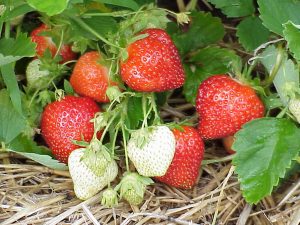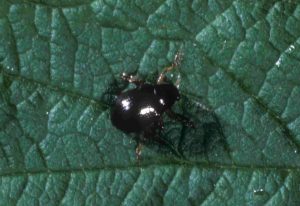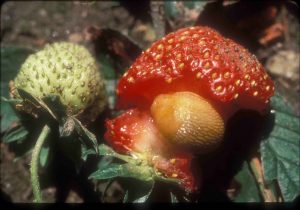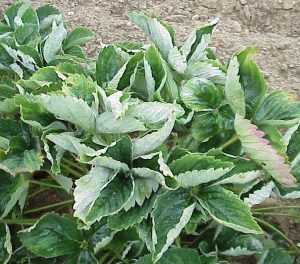Strawberry IPM Newsletter No. 3 – May 30, 2020
Strawberry IPM Newsletter No. 3 – May 30, 2020
Click on photos to enlarge

WARM TEMPERATURE HASTEN STRAWBERRY GROWTH
Clipper and Tarnished Plant Bug Active in Blooming Fields
Twilight Meeting: Tuesday, June 16, 2020 6:30pm at Blackie’s Farm Fresh Produce, in Auburn
Situation:
What a difference a week can make. Since we have had some very warm days and nights it has pushed strawberry flower development along this week. Early fields in southern Maine are now at or just beyond full bloom, with later varieties showing a few king blossoms. Some fields got hit with a late frost last weekend, and are showing some black-eyed flowers as a result. Most fields are dry, so irrigation is being run to reduce plant stress. The period from bloom to fruit ripening is one of the highest for water demand in strawberry plants. One to two inches of water per week is needed to assure good berry development and size.
Strawberry plants grow best when temperatures range from 60 to 75 degrees. When temperatures exceed 80 degrees, growth will slow down or stop. Brief applications of overhead irrigation (25 minutes) during high temperatures can reduce air temperatures around the plants by evaporative cooling. If you are set up with drip irrigation, it should be run in the morning when hot temperatures are predicted to help the plants cool themselves through evapotranspiration, i.e. water being drawn through the plants and evaporating from the leaves.
Strawberry bud weevil or “clipper”:
I have seen more clipped flower buds from strawberry clipper this week, mostly along the edges of the fields and in fairly low numbers. Early varieties in southern Maine are already past the susceptible stage for this pest, with most flower buds already open. But in late blooming varieties and more in northern regions growers should still be on the lookout. The control threshold for clipper injury is more than 1.2 clipped buds per two feet of row. Clipper damage can develop quickly under warm temperatures, so scout fields regularly. Insecticide options for clipper include Lorsban®, Brigade®, Bifenture®, Danitol®, Sevin® and PyGanic®. Clippers will also attack the buds of raspberries and blackberries, although they do not usually cause significant injury.
Tarnished plant bug:

I found the first nymphs of the season in strawberry fields this week. Very small (about 2 mm) first instar tarnished plant bugs are now active in some strawberry fields, but activity is still fairly low, and was only approaching threshold at one site. Fields with lots of weeds tend to have higher plant bug populations. Adult bugs are also active in the fields and are now laying eggs on strawberry leaves and flower stems, which will result in more nymphs appearing soon. It is important to scout for tarnished plant bug nymphs regularly, as they may appear very quickly with warm weather. The threshold for plant bug nymphs is 4 or more flower clusters infested with nymphs per 30 sampled. Scout fields with open flowers now. Insecticide options for tarnished plant bugs include malathion, Assail®, Brigade®, Bifenture®, Dibrom®, Danitol®, and PyGanic®.
Two-spotted spider mites:

I continue to find mites and eggs in most fields I have scouted, but populations are low at most sites, due to miticide applications and/or predator activity. Warm, dry weather could trigger a resurgence in mite populations, however it is important to scout for them regularly. If 25% of leaves sampled (e.g. 15 out of 60) have any mites, a spray should be applied. Chemical control options for two-spotted spider mites include Acramite®, Savey®, Zeal®, Portal®, Vendex®, Oberon®, Brigade®, and Danitol®.
Strawberry rootworm (not root weevil) adults and feeding injury are likely to start appearing soon. The adult stage of this insect is a small (1/8”) dark brown beetle. The beetles feed on strawberry leaves during the spring and late summer, causing numerous small holes in the leaves. The larvae are small grubs that feed on the roots of strawberry plants, causing them to be stunted and weak. If these beetles and/or feeding injury is prevalent in a field, a treatment is recommended. Sevin 50WP® is registered for control of this pest. Sprays can be timed to also control strawberry bud weevil. Strawberry rootworm should not be confused with root weevil, a larger insect that generally causes much more serious damage when present in a field.

Slugs may be a problem this season.

Moist conditions and mulch encourage the presence of these mollusks. Slugs usually feed at night, leaving large holes in the leaves and tunnels in the ripening fruit. Baits such as Deadline® and Sluggo® offer some control, but should be used prior to fruit ripening. Pay close attention to label instructions and precautions. Baits should also be applied to the fields in mid-September if slugs have been a problem, to reduce egg-laying for next year’s generation.
Diseases: gray mold (Botrytis)

is still the most important threat to strawberry fruit at this time. Flowers should be protected against infection by spores of the fungus with two to three sprays of fungicides during bloom, the first applied at 5-10% bloom, followed by a second at petal fall. An additional application may be applied when there is significant rainfall or irrigation following these sprays. Alternate fungicide products by families (FRAC numbers) to prevent the development of resistance.
Powdery mildew:

Some early symptoms of powdery mildew were noticed in one field this week, with upward cupping of the leaves and reddish streaking on the leaf and flower stems. This disease is likely to become more prevalent with warmer temperatures. Consider using a fungicide that will control powdery mildew, such as captan + Topsin-M®, or Pristine® when you’re spraying for gray mold.
Other Berries:
Highbush blueberries are starting to bloom in southern and mid-state regions. Mummy berry spore spread should be over, although northern growers may still consider another preventive fungicide application. Be on the lookout for Phomopsis twig blight; new shoot growth will wilt and turn brown, looking like flags on the bush. This blight tends to be more of an issue when winter injury is prevalent, as it requires a wound or damaged tissue to infect the plants. Pruning and copper-based fungicides can help manage this disease. See the New England Small Fruit Management Guide for details.
Raspberry canes are showing flower buds and new primocane growth this week. Delayed winter injury may become evident in the coming weeks as fruiting laterals on the canes start to elongate and flower, only to suddenly wilt and die. This delayed injury is due to the inability of the damaged vascular system to support this additional growth, especially in hot, dry weather. Keep an eye out for strawberry clippers and tarnished plant bugs on flower clusters. Raspberry cane borers will also be appearing soon, girdling new canes and causing the tips to wilt. Look for the ½” long narrow-bodied black beetles with orange necks near the base of the plants, or chewing on the canes near the tops.
Reminder: Twilight Meeting Tuesday June 16th at Blackie’s Farm Fresh Produce, 966 Minot Ave., Auburn, starting at 6:30 p.m. One pesticide applicator recertification credit will be awarded for the meeting. See you there!
For information regarding growing and marketing crops under COVID-19 restrictions please visit our webpage: Additional Resources During COVID-19
The most up-to-date version of the New England Small Fruit Management Guide is available online.
Remember, for pest management questions you can access this guide online at: UMass (NE Small Fruit Management Guide).
Sincerely,
David T. Handley
Vegetable & Small Fruit Specialist
Highmoor Farm UMaine Extension Diagnostic
P.O. Box 179 Research Lab, Pest Mgmt. Unit
52 U.S. Route 202 17 Godfrey Drive
Monmouth, ME 04259 Orono, ME 04473
207.933.2100 1.800.287.0279
The University of Maine is an equal opportunity/ affirmative action institution.
Where brand names or company names are used, it is for the reader’s information. No endorsement is implied nor is any discrimination intended against other products with similar ingredients. Always consult product labels for rates, application instructions and safety precautions. Users of these products assume all associated risks.
